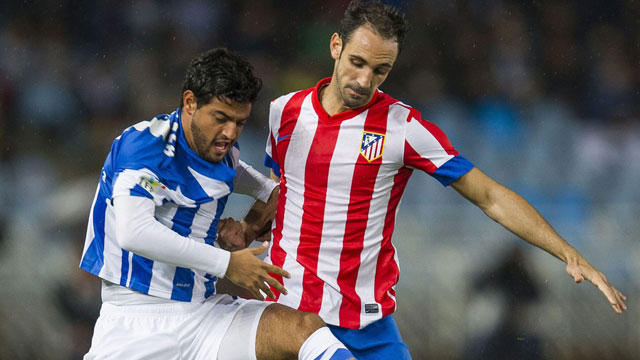“I found my swimming-suit, wrapped it in a comb with a towel, and went down-stairs and walked up the street to the Concha. The tide was about half-way out. The beach was smooth and firm, and the sand yellow…Out beyond where the headlands of the Concha almost met to form the harbor there was a white line of breakers and the open sea…I looked around the bay, at the old town, the casino, the line of trees along the promenade, and the big hotels with their white porches and gold-lettered names. Off on the right, almost closing the harbor, was a green hill with a castle.”
Ernest Hemingway loved San Sebastian.
It was there, on the beach of the nearly-closed-off Bay of La Concha, that Jake Barnes — the protagonist of The Sun Also Rises — found a bit of reprieve while his love interest, Brett Ashley, was romping with a bullfighter in Madrid.
Hemmingway visited the Basque city on the coast of the Bay of Biscay on numerous occasions during his life, and there are several photographs of him on the Concha beach, including one with his second wife, Pauline, in 1927 and with the painter Waldo Pierce in 1929. He’s wearing the same swimming-suit in both pictures.
Had he walked into town to buy some fruit to take back to his hotel in the morning, Hemingway would likely have found himself against the north-end bleachers of the Atotxa stadium, home of local football team Real Sociedad, and conveniently located next to a fruit market. And had he bought a ticket to a match, he would have been treated to some of the best football in Spain.
Just a few months after his picture was taken with Pauline on that yellow sand, Real Sociedad progressed all the way to the final of the Copa del Rey, where they were beaten 3-1 by Barcelona. And by the time he had posed for the camera alongside Waldo Pierce, Sociedad had signed on as a founding member of the new Primera Division. They finished fourth that first season, and striker Paco Bienzobas was presented the inaugural Pichichi award as top goal-scorer of the competition.
We don’t know if Hemingway ever went to a match at the Atotxa, but it’s safe to say he probably didn’t. It seems he preferred the ring of the corrida to the football ground.
Feel-good story
These days Real Sociedad play their home matches at the Anoeta, a curvy stadium located outside the city that replaced the iconic, albeit cramped, Atotxa in 1993. They also happen to be playing some of their best football since the 2002-03 season, when they finished just two points behind La Liga champions Real Madrid.
But while that achievement was mostly down to a lethal attack fronted by 20-goal scorers Nihat Kahveci and Darko Kovacevic, this time around their success has stemmed largely from the back, where Mikel Gonzalez and Inigo Martinez have kept things tight and organized in front of goalkeeper Claudio Bravo while contributing five goals, themselves.
In fact, only Barcelona have been able to rely on as much offense from the defense as Real Sociedad. Through 30 matches the Txuri-urdin defenders have scored 10 of the side’s 55 goals, two of which came last weekend (from Martinez and Alberto de la Bella) in a 4-2 win over Malaga.
The three points extended Real Sociedad’s lead over the Champions League quarterfinalists to four points, and with just eight matches remaining they are fourth in the table, battling for a Champions League berth and writing one of European football’s feel-good stories of the season.
Philippe Montanier has been its primary author.
Hired two years ago after guiding Ligue 1 side Valenciennes to respectable 10th and 11th-place finishes, the Real Sociedad manager has been drawing on experience gained in a previous job at Boulogne, where he earned promotion to the French top flight and was named League 2 Manager of the Year.
It was also at the Stade de la Liberation that Montanier earned a reputation for developing young players. And as Sociedad have been largely relying on their latest crop of youngsters since winning promotion from the Segunda in 2010, the 48-year-old is due his share of the credit for the club’s progression up the standings.
Not that he’ll ever get as much as Martinez, Asier Illarramendi, Antoine Griezmann or Carlos Vela.
Martinez, 21-years-old and one of the top, young defenders in Europe, is a reported transfer target of Barcelona and is seen in some quarters as the eventual replacement for Carlos Puyol, both at Camp Nou and for the Spanish national team. Illarramendi, 23, is the midfield engine and the team’s best distributor of the ball.
Then there’s Griezmann, one of the standout players of the 2011 FIFA U-20 World Cup and the dynamic, left-sided attacker in Montanier’s 4-2-3-1. His eight goals in La Liga are second on the team to former Arsenal striker Vela, who has tallied 13 times so far this season.
Man for man, Real Sociedad’s squad is one of the most technically-gifted in La Liga, and for that they have their youth setup at the Zubieta to thank. No fewer than 16 of the players available to Montanier came through at Real Sociedad B, where former Bosnia-Herzegovina international Meho Kodro has been training the club’s youngsters since 2008. And many of them, it goes without saying, share a common Basque heritage.
Basque influence
By the time San Sebastian had become a Hemingway getaway, Basque country had come to dominate Spanish football at both club and international level.
The Biscay Championship, which included the Basque clubs and those from Santander, was one of the most competitive tournaments in the country, and the 1920 Olympic side that came second to Belgium in Antwerp was made up of mostly Basque players — many of whom, including Francisco “Pagaza” Pagazaurtundua and Rafael “Pichichi” Moreno, were among the country’s first football superstars.
Real Sociedad, along with Athletic Bilbao and Barcelona, supplied four players to that Olympic team, the success of which served to popularize a sport that had hitherto been viewed as a largely English pastime.
All of this was taking place as Hemingway swam in the Bay of La Concha and posed for photographs on the San Sebastian beach. It happened right under his nose.
And wouldn’t it have been something if football had caught his fancy instead of bullfighting, if Death in the Afternoon had, instead, been Goals at the Atotxa.
The North American fondness for football would surely have been sooner in coming, and San Sebastian would have been idealized as more than white porches and a castle on a hill.
Jerrad Peters is a Winnipeg-based writer. Follow him on Twitter.

